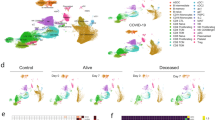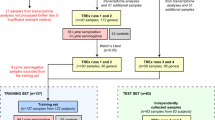Abstract
Gene expression profiles permit analysis of host immune response at the transcriptome level. We used the Pax gene Blood RNA (PAX) System and Affymetrix microarrays (HG-U133A&B) to survey profiles in basic military trainees and to classify them as healthy, febrile respiratory illness (FRI) without adenovirus, FRI with adenovirus, and convalescent from FRI with adenovirus. We assessed quality metrics of RNA processing for microarrays. Class prediction analysis discovered nested sets of transcripts that could categorize the phenotypes with optimized accuracy of 99% (nonfebrile vs febrile, P<0.0005), 87% (healthy vs convalescent, P=0.001), and 91% (febrile without vs with adenovirus, P<0.0005). The discovered set for classification of nonfebrile vs febrile patients consisted of 40 transcripts with functions related to interferon induced genes, complement cascades, and TNF and IL1 signaling. The set of seven transcripts for distinguishing healthy vs convalescent individuals included those associated with ribosomal structure, humoral immunity, and cell adhesion. The set of 10 transcripts for distinguishing FRI without vs with adenovirus had functions related to interferon induced genes, IL1 receptor accessory protein, and cell interactions. These results are the first in vivo demonstration of classification of infectious diseases via host signature transcripts and move us towards using the transcriptome in biosurveillance.
This is a preview of subscription content, access via your institution
Access options
Subscribe to this journal
Receive 6 digital issues and online access to articles
$119.00 per year
only $19.83 per issue
Buy this article
- Purchase on Springer Link
- Instant access to full article PDF
Prices may be subject to local taxes which are calculated during checkout




Similar content being viewed by others
References
Bullinger L, Dohner K, Bair E et al. Use of gene-expression profiling to identify prognostic subclasses in adult acute myeloid leukemia. N Engl J Med 2004; 350: 1605–1616.
Valk PJ, Verhaak RG, Beijen MA et al. Prognostically useful gene-expression profiles in acute myeloid leukemia. N Engl J Med 2004; 350: 1617–1628.
Rubins KH, Hensley LE, Jahrling PB et al. The host response to smallpox: analysis of the gene expression program in peripheral blood cells in a nonhuman primate model. Proc Natl Acad Sci USA 2004; 101: 15190–15195.
Barraza EM, Ludwig SL, Gaydos JC, Brundage JF . Reemergence of adenovirus type 4 acute respiratory disease in military trainees: report of an outbreak during a lapse in vaccination. J Infect Dis 1999; 179: 1531–1533.
Gray GC, Goswami PR, Malasig MD et al. Adult adenovirus infections: loss of orphaned vaccines precipitates military respiratory disease epidemics. For the Adenovirus Surveillance Group. Clin Infect Dis 2000; 31: 663–670.
Thach DC, Lin B, Walter E et al. Assessment of two methods for handling blood in collection tubes with RNA stabilizing agent for surveillance of gene expression profiles with high density microarrays. J Immunol Methods 2003; 283: 269–279.
Auer H, Lyianarachchi S, Newsom D et al. Chipping away at the chip bias: RNA degradation in microarray analysis. Nat Genet 2003; 35: 292–293.
Affymetrix. GeneChip® expression analysis data analysis fundamentals. Part No. 701190 Rev. 4. p 39. Available at http://www.affymetrix.com/support/downloads/manuals/data_analysis_fundamentals_manual.pdf. Accessed Sept. 2004, 2004.
Golub TR . Toward a functional taxonomy of cancer. Cancer Cell 2004; 6: 107–108.
Affymetrix. Performance and validation of the GeneChip® human genome U133 set. Available at http://www.affymetrix.com/support/technical/technotes/hgu133_performance_technote.pdf. Accessed March 2005, 2002.
Affymetrix. Globin reduction protocol: a method for processing whole blood rna samples for improved array results. Available at http://www.affymetrix.com/support/technical/technotes/blood2_technote.pdf. Accessed March 2005, 2003.
Preanalytix. Product circular. PAXgene Blood RNA tube. Available at http://www.preanalytix.com/pdf/prodcir.pdf. Accessed Sept. 2004.
Jurgensen S, Schram J, Herdman C, Rainen L, Wyrich R, Oelmueller U . Effect of blood collection and storage conditions on gene expression analysis. Available at http://www.preanalytix.com/pdf/SJAMPposterNov01.pdf. Accessed April 2003.
Jurgensen S, Schram J, Herdman C, Rainen L, Wyrich R, Oelmueller U . New technology to stabilize cellular RNA in blood. Available at http://www.preanalytix.com/pdf/AMP2000PosterSJ.pdf. Accessed April 2003.
Preanalytix. PAXgene blood RNA kit handbook. Available at http://www.preanalytix.com/pdf/RNA_handbook.pdf. Accessed Sept 2004.
Li C, Hung Wong W . Model-based analysis of oligonucleotide arrays: model validation, design issues and standard error application. Genome Biol 2001; 2 RESEARCH0032.
Li C, Wong WH . Model-based analysis of oligonucleotide arrays: expression index computation and outlier detection. Proc Natl Acad Sci USA 2001; 98: 31–36.
Hosack DA, Dennis Jr G, Sherman BT, Lane HC, Lempicki RA . Identifying biological themes within lists of genes with EASE. Genome Biol 2003; 4: R70.
Acknowledgements
We thank the study participants and F Ligler and J Golden for reviewing the manuscript. This work was supported in part by the Defense Threat Reduction Agency, HQ USAF Surgeon General's Office, Office of Naval Research, and the Naval Research Laboratory. The opinions and assertions contained herein are the private ones of the authors and are not to be construed as official or reflecting the views of the Department of Defense. The EOS Consortium is an Air Force Medical Service initiative comprised of: Sponsorship: P Demitry1, T Difato1; Executive Board: E Hanson4, R Holliday2, R Rowley4, C Tibbetts4; Operational Board: D Stenger10, E Walter5, J Diao2; Technical Advisors & Collaborators: R Kruzelock6, B Agan10, L Daum11, D Metzgar12, D Niemeyer11, K Russell12; Research & Clinical Staff: M Archer9, R Bravo3, N Freed12, J Fuller12, J Gomez3, K Gratwick12, M Jenkins10, M Jesse3, B Johnson3, E Lawrence3, B Lin8, C Meador9, H Melgarejo3, K Mueller9, C Olsen2, D Pearson3, A Purkayastha2, J. Santiago3, D Seto7, F Stotler3, D Thach8, J Thornton9, Z Wang8, D Watson3, S Worthy3, G Vora8; Operations Support Staff: K Grant2, C James2. Affiliations: Dept. of 1USAF/SGR, 2USAF/SGR (Ctr), 3Lackland AFB, 4George Washington University, 5Texas A&M University Systems, 6Virginia Tech, 7George Mason University, 8Naval Research Laboratory, 9NOVA Research Incorporated, 10Wilford Hall Medical Ctr, 11Air Force Institute for Operational Health, 12Navy Health Research Ctr.
Author information
Authors and Affiliations
Consortia
Corresponding author
Rights and permissions
About this article
Cite this article
Thach, D., Agan, B., Olsen, C. et al. Surveillance of transcriptomes in basic military trainees with normal, febrile respiratory illness, and convalescent phenotypes. Genes Immun 6, 588–595 (2005). https://doi.org/10.1038/sj.gene.6364244
Received:
Revised:
Accepted:
Published:
Issue Date:
DOI: https://doi.org/10.1038/sj.gene.6364244
Keywords
This article is cited by
-
Of mice and men: the host response to influenza virus infection
Mammalian Genome (2018)
-
Optimization of a high-throughput whole blood expression profiling methodology and its application to assess the pharmacodynamics of interferon (IFN) beta-1a or polyethylene glycol-conjugated IFN beta-1a in healthy clinical trial subjects
BMC Research Notes (2013)
-
Transcriptional signatures as a disease-specific and predictive inflammatory biomarker for type 1 diabetes
Genes & Immunity (2012)
-
Assessing the human immune system through blood transcriptomics
BMC Biology (2010)



